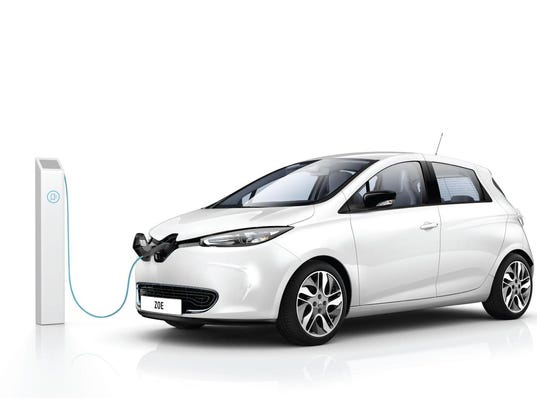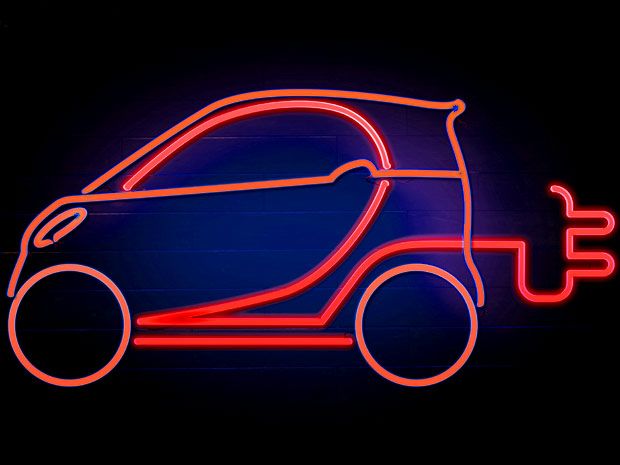
DetroitNews.com: As falling fuel prices make electric cars even less attractive to buyers, spare a thought for the manufacturers caught between the rock of governments forcing ever tighter fuel rules, and the hard place of needing to sell more of a product nobody wants, yet.
In Europe, manufacturers will have to grit their collective teeth and subsidize the sale of electric cars and plug-in hybrids, knowing that if they fail to back the sale of these loss-makers, the penalties from the European Union (E.U.) for not meeting their average fleet fuel economy rules will be even more expensive.
The French-Japanese alliance of Renault and Nissan is arguably the worst affected car manufacturer, after pledging $5 billion to produce electric cars and batteries to meet its prediction that 10 percent of global car sales will be electric only by 2020. That estimate has proved to be wildly and embarrassingly off the mark.
According to IHS Automotive, regular hybrids and plug-in hybrid electric vehicles (PHEV) will prove relatively more attractive than battery only vehicles, in the medium term, although neither will be setting the sales charts alight. By 2020 regular hybrids and PHEVs will account for almost five percent of global sales compared with less than one percent for electric only vehicles.
By 2025, battery-only will have slowly expanded to 1.5 percent, while PHEVs and hybrids will stagger just past six percent, IHS Automotive says. Fuel cell vehicles, now being pushed by Toyota, will barely register at all by 2025. In 2013, both battery-only and PHEVs barely registered on global sales radar. It's clear that internal combustion engine power will dominate for years to come.
Barely perceptible
In the U.S., the market penetration of electric only vehicles in the first nine months of 2014 was a barely perceptible 0.35 percent, according to Automotive Industry Data (AID).
Latest data on electric only vehicle sales in Western Europe showed that in August sales slowed for the third month in a row to 4,045 from 4,381 the previous month and 5,350 in June, AID said. In the first eight months of 2014 sales jumped to 35,228 from 20,052 in the same period of 2013, but the growth pace was fading, according to AID, in a report entitled "Electric car sales pace, far from growing, is slowing." Electric vehicle market share in Western Europe in the first eight months was 0.44 percent compared with 0.26 percent in the same period of 2013. But these numbers are distorted by oil-rich and socialist Norway's simulated love of electric cars. Electric car sales there are boosted by government subsidies, and parking and charging concessions. Without Norway's input, the market share figures for Western Europe are a derisory 0.28 percent versus 0.22 percent. The numbers include sales of the Nissan Leaf, Renault Zoe, Tesla Model S, VW e-Up, e-Golf, and BMWi3. They also include the Chevrolet Volt/Opel Ampera, which are extended range electric vehicles.
This reversal of a trend that was never very strong anyhow is down to the unexpected fall in fuel prices, AID editor Peter Schmidt says, and it presents car manufacturers with a problem; lose money by subsidizing the sale of electric vehicles, or lose more by failing to meet the targets set by the E.U.
Tougher in 2021
The E.U. rules require an average fuel consumption equivalent to 57.4 miles per U.S. gallon by 2021. The regulations are even more stringent than the U.S. ones, which demand average fuel consumption of 54.5 mpg by 2025. Current E.U rules require 43 mpg by 2015, and most manufacturers are on course to meet that. The tougher 2021 E.U. targets though will require massive sales of electric only and PHEVs. There is talk that a little known clause in U.S. regulation calls for a review in 2017, when the standards could be diluted. U.S. manufacturers must be crossing their fingers.
AID's Schmidt said the current fall in the oil price is persuading U.S., and to a lesser extent European car buyers, to return to large pickups and SUVs, while giving small, fuel efficient cars a miss.
"The question on the minds of some skeptics now is, as various commentators have put it most topically "will $80 oil kill the electric car?" Highly unlikely. But given that these cheaper oil conditions will stay with us for a few years rather than just months (new reserves because of U.S. fracking) chances are that between now and 2020 for instance, electric car inroads — which are already progressing at snail's pace — are now unlikely to pick up added notable momentum," Schmidt said.
"What was going to happen by 2025 will now happen by 2030," he said.
The market penetration of electric vehicles maybe be receding, but the fuel economy rules remain cast in concrete.
"The car manufacturers have very little choice but to move towards a technology that will enable them to meet these rules. If they fail they will have to pay astronomical fines. Manufacturers may be forced to sell every one of their electric and plug-in cars at a loss. It's probably cheaper to subsidize these sales than pay the fines," Schmidt said.
Electric car positives
Not everybody has such a dim view of the immediate prospects for electric cars.
Ratings agency Standard & Poors, in a report on electric cars, said because of recent improvements in battery technology, these vehicles could begin to cut into gas-powered vehicle sales in the U.S. over the next five years.
"We believe technological advances are shortening the time to when EVs could become truly competitive with gasoline-powered vehicles and begin to shake up business models in the auto industry," the report said.
The report came to these conclusions:
• Given recent advances in lithium-ion battery technology, electric vehicles are showing increasing potential to challenge the auto industry's long-standing gas powered business model.
• Zero-emission policies are also promoting demand for EVs.
• EV technology still faces hurdles such as high unit costs, limited driving range and lack of recharging stations. However we see significant advances in these areas.
• As with any new breakthrough technology, the exact timing of a broader changeover to EVs is difficult to predict.
The report didn't say if it agreed with the IHS Auto predictions, offer any firm ones of its own, or explain how auto manufacturers' balance sheets would be affected by being forced to sell an increasing number of very-expensive-to-develop vehicles at a huge loss.
Professor David Bailey of the Aston Business School agrees that electric vehicle sales continue to disappoint, partly, he says, from initial over-hyping, and Renault-Nissan is the leading mourner.
"Renault-Nissan placed more bets on EVs than any mainstream auto maker and has shifted just 4,200 Zoe's so far this year, massively below management's initial hopes. CEO Carlos Ghosn said last year that electric vehicle sales were at least four years behind targets, and he blamed this on the slow rollout of support infrastructure (charging points)," Bailey said.
Nissan-Renault mess
"This all leaves Renault in a bit of a mess on the EV front given its big investment in this area," he said.
And it's not just Renault that will be gritting its collective teeth, says AID's Schmidt.
"It's probably cheaper to underwrite the losses on every electric car because the (E.U.) fines would be significantly higher (for failing to meet targets). The manufacturers are being squeezed on two sides. On the one hand the European Union is saying do this or pay up, while on the other hand you've got electric cars that nobody wants to buy, unless you make them affordable which means losing money on very one. On balance, the latter may be the preferred route," Schmidt said.




